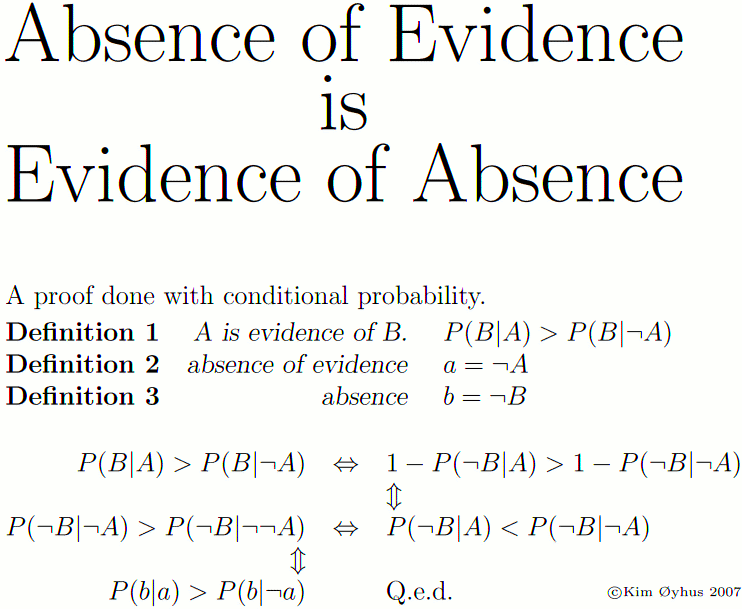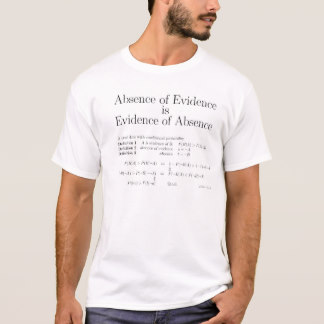
Why did I make this proof?
People quite often state wrongly that
"Absence of evidence is NOT evidence of absence."
Why do they do that? Perhaps because they do not
know better? And with this proof they get the possibility
of knowing for sure that
"Absence of evidence IS evidence of absence.",
which is quite useful in many situations, such as these:
Absence of evidence for...
- ...fairies, trolls, and ghosts...
- ...weapons of mass destruction in Iraq...
- ...crop circle aliens...
- ...gods...
- ...Microsoft patents in Linux...
- ...miracle healings...
- ...credentials...
- ...CO2 from machines causing global warming...
- ...UFO space ships...
- ...telepaty, ESP, and telekinesis...
- ...Linux stealing code from SCO corporation...
...means they get less likely all the time.
|
|
Buy a mug or shirt with the proof!
|
|
|
This is the reason that faith is bad. Faith is the assumption of truth
when evidence is absent. This absence of evidence is evidence of
absence of truth. So faith in itself is evidence of
falseness. Therefore, faith is not a road to truth, but instead a road
to falseness.
Blindly following orders is also bad. The absence of a good reason for
an order is evidence that the order is bad, since absence of good is
bad.
Carl Sagan is often quoted as saying "Absence of evidence is not
evidence of absence", but he meant it as an example of what fools
mean, and has since been consistently misquoted as something he meant.
Correct quote by
Wikiquote.
Misquote by
Quotationspage.
One source of this confusion may be that "evidence" is a near
synonym to both "proof" and "sign/indication" which are
two different concepts. Using these words instead gives the two
following correct sentences:
- Absence of sign/indication is a sign/indication of absence.
- Absence of proof is not proof of absence.
More serious is the American Statistical Association, who even sells
a T-shirt with the wrong slogan on it. Being statisticians, they
really should know better. Considering the large number of members
who could have pointed out this error, it is rather telling
that it is still there.
There was a previous
version of this proof, but this new one is much
shorter, simpler, and it also defines the concept of evidence,
which is also very useful and absolutely necessary to understand what
the proof is about, which many never did understand.
I have seen that the comprehension of this "absence of evidence"
concept is one of the main differences between sensible and gullible
people. Gullible people will not and cannot understand this concept.
A less proofy explanation:
For those of you who have not learned Bayesian inference yet, here is
an explanation with words, examples, and analogies:
More women than men wear skirts.
Both women and men can use trousers instead of skirts.
Skirts for men are kalled kilts, and
are usual in Scotland.
Thus there are 4 possibilites:
| A | man | without | a skirt |
| A | woman | without | a skirt |
| A | woman | with | a skirt |
| A | man | with | a skirt |
A skirt is evidence of a woman, because
there are more women than men wearing skirts.
So, if you see someone NOT wearing a skirt,
then it is more likely a man.
I get to use my shirt:
A Jehovas witness rang on my door, and I heard her coming, so I got
my "Absence of Evidence" shirt on just in time to greet her.
This Jehovas witless was typical, babbling incoherently about Bible
stuff. So I gently steered her toward evidence and proof, which
turned out to be surprisingly easy, and she babbled happily away about
biblical proof and the faith's proof for a while.
So I said to her "You do not know of what you speak, since you would
not even recognize a proof if it was right in front of your nose!",
while i put my chest closer to her face and pointed to the proof
there.
She looked at me as if I were a devil, clammed shut, and went away
with an arrogantly superior and offended expression. So I was obviously
completely right about her.
Lastly, an anecdote from Roar Lauritzsen about Absence of Evidence:
"Suppose you are a programmer, and you are looking for bugs in a
program. At first you cannot sleep at night because you are convinced
that there must be a bug somewhere, you just haven't found it yet. To
find the bug, you test the program to see if you find something that
doesn't work as you expected. If you found something, it would be
evidence that there was a bug. If you test the program a lot, and still
find no evidence of a bug, this increases your confidence that there is
no bug. In other words, it counts as evidence for the absence of a bug,
and you are finally able to sleep better.
After a while, your program is thoroughly tested, and you still find no
evidence for a bug. You begin to suspect that there might not be a bug
after all. However, if there is no bug, you will have no purpose as a
programmer. You feel as if your life depends on the existence of a
bug. You are now looking for the Bug that will save you. You believe
that there must be a Bug, so you test your program even more thoroughly.
When you still cannot find any evidence for a Bug, you start to
rationalize: Although I cannot find any Bug, that does not prove that
there is no Bug. You are now a true believer in the Bug."
PS: A nice comment,
in Spanish.
PS: A nice
article, with pretty pictures.
2010-5-13: I am on Seth Robert's
blog
2010-5-14: And then on
boingboing



